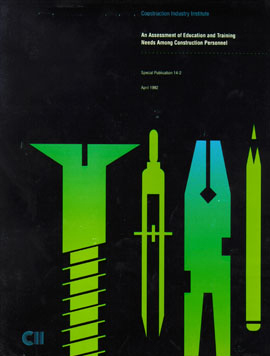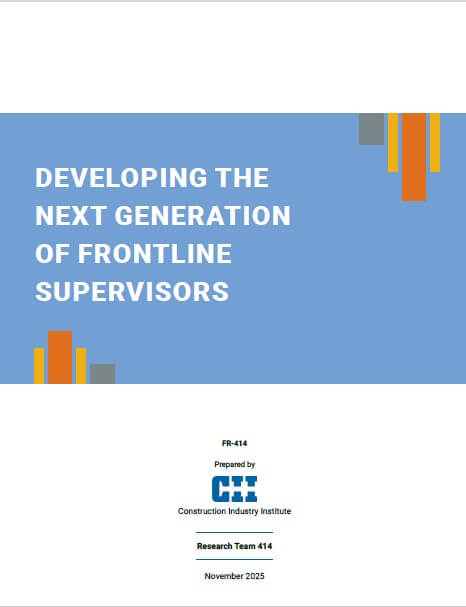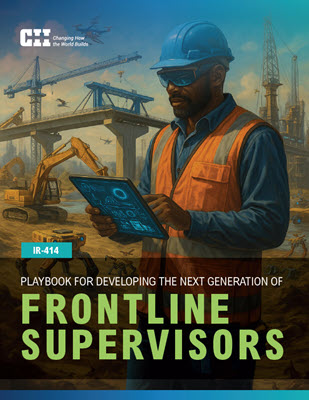
An Assessment of Education and Training Needs Among Construction Personnel
The mission of the Construction Industry Institute is “to improve the total quality and cost effectiveness of the construction industry through research and implementation for the purpose of providing a competitive advantage to U.S. business in the global marketplace.” Human resources are the most valuable aspect of any effort to upgrade productivity and quality control. Therefore, to attain the goal of more and better construction for the money, it is necessary to upgrade the supply and preparedness of human operatives at all levels. To undertake such an ambitious project, the CII Education and Training Task Force first brought its own experience and knowledge to the issue, then reviewed The Business Roundtable Construction Industry Cost Effectiveness (CICE) studies plus the work of several experts, governmental agencies, institutions, associations, and companies. The investigative effort culminated in the task force’s conducting a national assessment survey to obtain the views of many other parties active in the construction industry.
The national study was conducted using a special matrix instrument designed to compare a list of 10 skill/traits to 11 position/functions in the construction performance hierarchy, from senior executive to subjourneyman. The survey was sent to several segments of the construction industry, constructors, owners, academics, and design professionals (in order of number of respondents) with the dual objectives of:
- Determining broad perceptions of the current state of construction education and training
- Gaining observations on how requisite skills and traits should be acquired to perform well in the various positions in the construction industry
The responses produced a comprehensive set of views representative of the industry. Several hypotheses were supported; others received new light. Widely held perceptions of the respondents are that current education and training at all levels are not adequate to meet the needs of the construction industry, and that the problem is particularly acute in view of the anticipated emergence of more complex technologies. It also became clear that:
- Education and training are viewed as a continuum over a career.
- Formal education provides approximately 30 percent of the preparation needed to perform in a career. Thus it should concentrate on fundamental knowledge and skill development in communications and problem solving.
- Beyond formal education, a combination of special training and on-the-job experience should provide the other 70 percent of career preparation through ongoing individual improvement and adaptation to the changing needs of the industry and of the society at large. Continuing education is lifelong.
A path forward and blueprint for action should include both a short-term strategy and a long-term strategy. The highest immediate priority is craft training, followed by attraction of youth to construction careers, improvement of jobsite supervisory personnel, and expansion of management training beyond college. The long-term strategy involves improvement of primary/secondary education including vocational training, review of two- and four-year college curricula, and emphasis on unified continuing education programs. Retention is as important as recruitment. A positive relationship exists among training, rewards, and career development. The task force feels that improved training will lead to improved rewards and longer construction careers.
Continuing education centers are proposed, involving colleges and universities along with contractor associations and local user councils. Such centers will engage several levels of education and training depending on local needs.
The task force drew inferences from the study and other investigations which led to the following key recommendations:
- Critical review is needed of all formal education, from primary/secondary (which prepares personnel to function in all occupations) to college programs that prepare management personnel for construction.
- In regard to primary/secondary education, representatives of the construction industry should join other entities at the local, state, and national levels to help improve this vital link in the chain.
- Contractors and owners should make it clear to educators that construction needs well educated people, not high school dropouts; that construction is not just “grunt” work, but needs craft and technical people who can continue learning in a complex industry while enjoying rewarding careers.
- Construction, particularly the trades, should become more rewarding in terms of prestige, steady employment, ongoing careers, and remuneration, including benefits.
- Equal attention should be paid to retention as well as recruitment to offset the “30-year-old” exiting syndrome (whereby personnel tend to leave the industry when reaching the age of 30).
- Craft training requires serious improvement in both technical and communication skills. Cooperation is needed among public institutions, contractor associations, owner councils, unions, and the workers themselves.
- Special attention should be given to recruitment, training, orientation, and incentives for foremen and trade superintendents. Regular curricula should be developed at the two-year college level in which leadership, communication, problem solving, and personnel relations are emphasized for supervisory candidates.
- While college level education is ample in quantity to produce the needed managers, support personnel, and supervisors, the quality of that education requires ongoing attention. Constructors should become involved by serving on college advisory councils and accreditation boards and by serving as resources such as guest lecturers, jobsite tour hosts, career day organizers, and internship employers.
- Continuing education in construction needs to be upgraded through the efforts of academic institutions, contractor associations, and owner (user) councils.
- Individual companies should become more organized in their employee development and career planning programs.
- The many association-based and entrepreneurial training programs which have sprung up in the past two decades should be encouraged, but some form of quality control is recommended.
- If construction will indeed be increasingly dependent on a less qualified labor force, then special training linked to on-the-job experience becomes even more critical.
A path forward and blueprint for action should include both a short-term strategy and a long-term strategy. The highest immediate priority is craft training, followed by attraction of youth to construction careers, improvement of jobsite supervisory personnel, and expansion of management training beyond college. (SP14-2, p. vi)
The long-term strategy involves improvement of primary/secondary education including vocational training, review of two- and four-year college curricula, and emphasis on unified continuing education programs.
Education and training are viewed as a continuum over a career. This publication provides a blueprint for improvement with both a short-term and long-term strategy.
- Short-term strategy focus on immediate returns such as craft training, attract and retain new works, jobsite supervision and management training among others.
- Long-term strategy focus extended to primary/secondary education, vocational education, college level curricula and continuing education.



